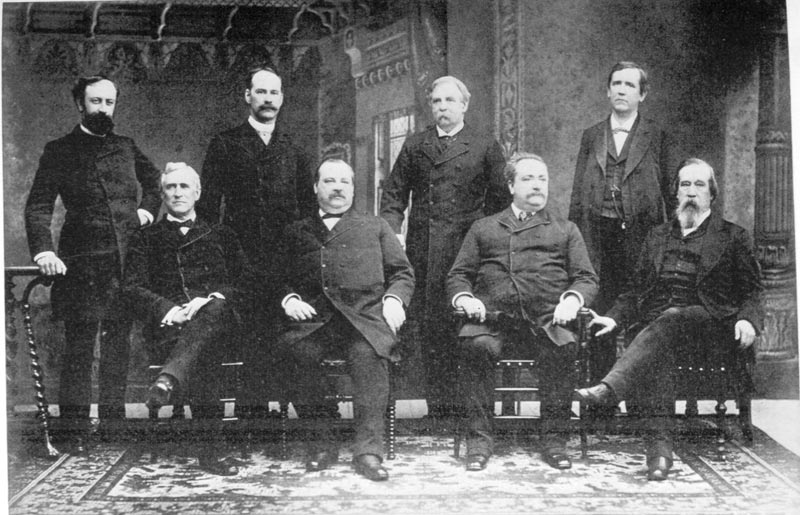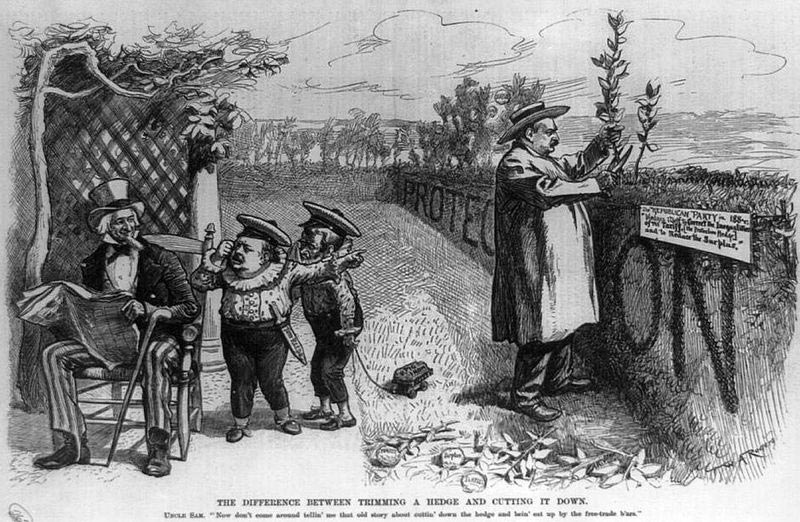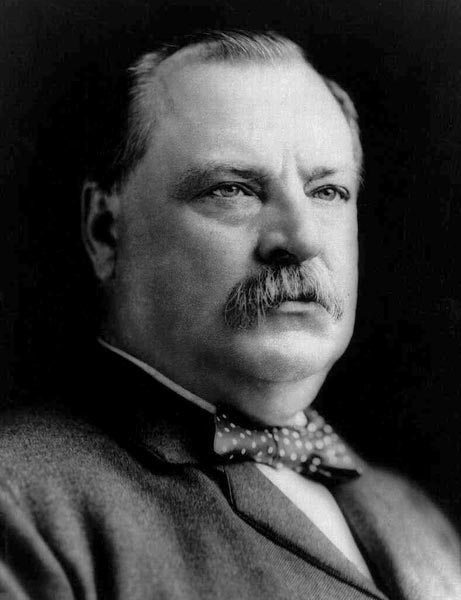| U.S. Presidents 16-25 | |
| 16. Abraham Lincoln (1861–1865) | |
| 17. Andrew Jackson (1865-1869) | |
| 18. Ulysses S. Grant (1869-1877) | |
| 19. Rutherford B. Hayes (1877-1881) | |
| 20. James A. Garfield (1881-1881) | |
| 21. Chester A. Arthur (1881-1885) | |
| 22. Grover Cleveland (1885-1889) | |
| 23. Benjamin Harrison (1889-1893) | |
| 24. Grover Cleveland (1893-1897) | |
| 25. William McKinley (1897-1901) | |
| List of All the Presidents |
Stephen “Grover” Cleveland, more commonly known as Grover Cleveland, was the twenty-second and the twenty-fourth President of the US. He was the only American president to ever serve in two non-successive terms. He was leader of the Bourbon Democrats, a group of Americans who supported businesses and were against unjustifiable tariffs, inflation, imperialism and other business subsidies. He was viewed as a symbol of conservatism due to his views on political reforms, in which he committed himself to classical liberalism. In his terms he battled corruption and bossism in politics until the Panic of 1893. Though he was unable to oppose the problems that the era presented, he was still seen as an honest and kind politician.
Early Life
It was the 18th of March 1837 when Stephen Cleveland was born in Caldwell, New Jersey. His father, Richard Falley Cleveland served as a minister of the Presbyterian Church of English ancestry and belonged to the first Cleveland of his clan to migrate from England to Massachusetts in the year 1635. On the other hand, Grover’s mother, Ann Neal Cleveland, was a bookseller’s daughter hailing from Baltimore. Ann descended from Protestants and German Quakers of Anglo-Irish ancestry. Stephen had a distant relationship with General Moses Cleveland, whom the city of Cleveland, Ohio was named after.
Grover Cleveland was the fifth of nine siblings. He was named Stephen Grover in honor of the First Presbyterian Church of Caldwell’s first ever pastor. In his later years, however, he would refrain from using Stephen as his name. In the year 1841, his family moved to Fayetteville, New York. As a child, he was frivolous and a bit mischievous, qualities which people close to him noticed. He also shared a love for playing outdoor sports. In 1850, however, the family moved to Oneida County, New York as part of his father’s pastorate occupation. Richard Cleveland died after he and his family moved to Holland Patent in 1853.
Education and Career
 Grover studied in Fayetteville Academy before his father died. He soon quit his studied to tend after his family. He was soon hired as an assistant teacher by his brother at the New York Institute for the Blind in the city of New York. A year later, Cleveland moved to Buffalo, where he worked as a cleric under his uncle, Lewis Allen. Allen introduced Cleveland influential people. In the end, he was hired in the law firm of Rogers, Bowen and Rogers, where he was admitted to the bar years later after getting promoted to Chief Clerk.
Grover studied in Fayetteville Academy before his father died. He soon quit his studied to tend after his family. He was soon hired as an assistant teacher by his brother at the New York Institute for the Blind in the city of New York. A year later, Cleveland moved to Buffalo, where he worked as a cleric under his uncle, Lewis Allen. Allen introduced Cleveland influential people. In the end, he was hired in the law firm of Rogers, Bowen and Rogers, where he was admitted to the bar years later after getting promoted to Chief Clerk.
Grover became a lawyer and left the law firm in 1862. He leaned towards the Democratic Party, running for the position of District Attorney. He lost to one of his companions and roommates, Lyman Bass. He soon reentered law practice in the year 1870. Afterwards, he ran for sheriff during the Erie County elections, which he won. He was thirty-three years old.
Cleveland did not run for the second time after ending his term. In the year 1881, the Democrats nominated him for the mayoral position, which he accepted. He won Mayor with a total of 15,120 votes. He began his term January 2, 1882. As a leader he refused to sign any document that might give way to corruption, allowing his reputation as an honest man to gain widespread attention.
Grover Cleveland’s Presidency
 On July 1884 he was nominated as President with Maine’s James Blaine as his running opponent. Ten days later a scandal erupted. Media began reporting Cleveland as an illegitimate father of an eleven-year-old child, an allegation which he had difficulty denying. Truth had been his main factor in running as president, and he soon admitted supporting a child when it fact he was still unsure who the father is. This admittance allowed the Republicans to lambast his character with rude slogans highlighting this issue. It was when Samuel Burchard, a supporter of Blaine, spoke about the Democrats being a party of “rum, Romanism and rebellion” when Cleveland’s party made use of the insult. The popular vote was tight, and he won by a quarter of a percent, whereas he won the majority of electoral votes, with a close number of 219 to 182. Blaine lost the race and Grover Cleveland became president.
On July 1884 he was nominated as President with Maine’s James Blaine as his running opponent. Ten days later a scandal erupted. Media began reporting Cleveland as an illegitimate father of an eleven-year-old child, an allegation which he had difficulty denying. Truth had been his main factor in running as president, and he soon admitted supporting a child when it fact he was still unsure who the father is. This admittance allowed the Republicans to lambast his character with rude slogans highlighting this issue. It was when Samuel Burchard, a supporter of Blaine, spoke about the Democrats being a party of “rum, Romanism and rebellion” when Cleveland’s party made use of the insult. The popular vote was tight, and he won by a quarter of a percent, whereas he won the majority of electoral votes, with a close number of 219 to 182. Blaine lost the race and Grover Cleveland became president.
Grover was inaugurated on the 4th of March 1885. He made it a point in his inaugural speech the country’s need for reformation and its severity to legislations of special interests. He rejected more than three hundred bills and immediately reduced high tariffs. He also oversaw the Interstate Commerce Act of 1887.
In 1886, Cleveland married Frances Folsom, the daughter of his friend Oscar, inside the White House. This marked the first time a marriage happened within the building’s walls. Frances bore five children.
Second Term
In 1888, Cleveland was re-nominated. The Republicans, on the other hand, chose Benjamin Harrison, President William Harrison’s grandson. Grover lost the election and Benjamin won with an impressive number of 233 against 168. It is reported that before leaving the White House, Frances told a housekeeper to keep everything until her husband’s return in office. Her prediction came true when, in 1893, Cleveland won the presidential elections for the second time, making him both the twenty second and the twenty fourth President of the United States.
As soon as his new term began, the infamous Panic of 1893 severely damaged the country’s stock market. It was marked by the collapse of the railroad financing, resulting in failures within banks. It was not until the Great Depression when the Panic was considered as the worst economic problem the United States had ever experienced.
 During this problematic era, Cleveland had already reversed the silver policy which was formed during Harrison’s administration. The Panic of 1893 had so far injured the conditions of labor within the country. Jacob S. Coxey, a socialist, marched with workmen east towards Washington DC to rally against these new policies. This group of workmen, soon known as Coxey’s Army, protested for proper occupation and treatment amongst laborers. A few hundred of them remained once they had reached Washington. Their arrest began when they started to step on the grass of the United States Capitol. Coxey’s Army was seen not as a threat, but a symbol of the increasing agitation amongst the people towards Eastern monetary policies. A similar strike, known as the Pullman Strike, produced a greater effect on Cleveland’s office. More than a hundred thousand railroad workers went on strike, damaging the commerce of the entire nation, considering how mail is delivered via train. Grover Cleveland soon had no choice but to send federal troops to Chicago. The plan worked, but the laborers toughened their attitude towards the president’s administration.
During this problematic era, Cleveland had already reversed the silver policy which was formed during Harrison’s administration. The Panic of 1893 had so far injured the conditions of labor within the country. Jacob S. Coxey, a socialist, marched with workmen east towards Washington DC to rally against these new policies. This group of workmen, soon known as Coxey’s Army, protested for proper occupation and treatment amongst laborers. A few hundred of them remained once they had reached Washington. Their arrest began when they started to step on the grass of the United States Capitol. Coxey’s Army was seen not as a threat, but a symbol of the increasing agitation amongst the people towards Eastern monetary policies. A similar strike, known as the Pullman Strike, produced a greater effect on Cleveland’s office. More than a hundred thousand railroad workers went on strike, damaging the commerce of the entire nation, considering how mail is delivered via train. Grover Cleveland soon had no choice but to send federal troops to Chicago. The plan worked, but the laborers toughened their attitude towards the president’s administration.
During the Panic, Cleveland had already paid visits to New York for an operation. Epithelioma, a cancer of the tissue, was found on the roof of his mouth. The surgery, which happened on the first of July, was a success, though it was kept in secrecy to avoid further public panic. The media only went as far as reporting the removal of the president’s two teeth. When the newspapers began detailing the actual surgery, the surgeons involved in the rumor had successfully denied the gravity of Cleveland’s condition.
By May of 1894, Grover Cleveland continued to battle the country’s worsening economic problems. He had asked to repeal the Sherman Silver Purchase Act, which was passed with the help of Republican senators. Two years later, only forty million dollars of gold were left in the country’s Treasury. To stop this dangerous flow of cash, Cleveland came up with an organization of bankers and invoked against Great Britain the Monroe Doctrine.
After Serving Office
At the end of his second term, Cleveland refused to be nominated again. The Democratic Party soon nominated William Jennings Bryan, but they lost to the McKinley. Grover and his family soon moved to Princeton, New Jersey, at his estate, the Westland Mansion. He became a Trustee in Princeton University a few years later. He occasionally befriended President Theodore Roosevelt, whose invitation to become chairman of the Coal Strike of 1902 Commission he rejected. Soon the Equitable Life Assurance Society appointed him to the board of trustees. He became head of the Association of Presidents of Life Insurance Companies. He continued writing down his views on politics. In an article on The Ladies Home Journal, he wrote against suffrage for women.
For years, Cleveland suffered various ailments on his heart and kidney. In the autumn of 1907 he got terribly ill. He soon died on June 24, 1908 due to a heart attack. He was seventy-one. “I have tried so hard to do right,” were his last words. His body was buried in Princeton Cemetery.
Various memorials emerged after the former president’s death. Cleveland’s portrait was seen on the thousand dollar bill of 1928 and 1934. In the year 2006, Free New York, which is a nonprofit group of researchers, started to raise funds in order to buy Fairfield Library in Buffalo and renovate it into the Grover Cleveland Presidential Library and Museum.
